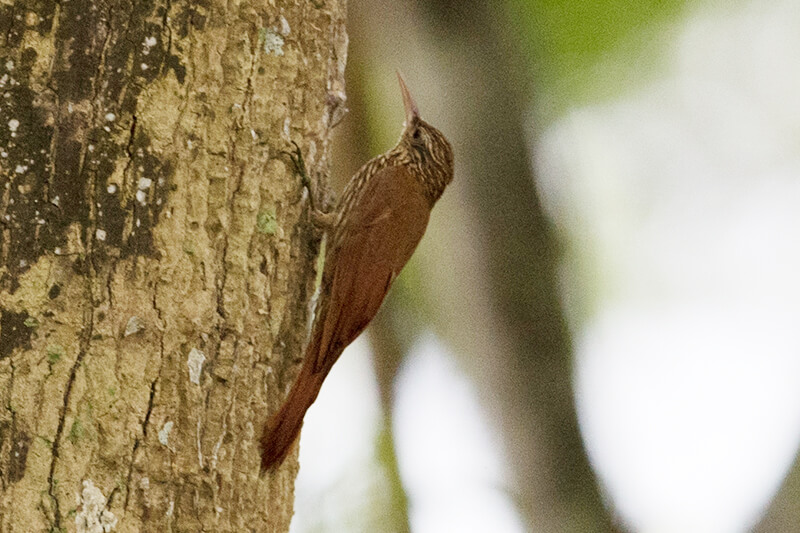Montane Woodcreeper
TREPADOR MONTAÑERO
Lepidocolaptes lacrymiger
As a climber of tree trunks, this woodcreeper has very rigid feathers that allow it to support its body weight while it explores trunks. Its feet are modified for climbing. The front toes are strongly clawed, and two of its toes are of the same length to increase its ability to grasp around and under branches. If it lost its tail, then it would be difficult for the bird to climb a trunk. The legs are short and strong. By flexing its legs it can climb by hopping. It has brown eyes, and its back is brownish-reddish or ochre colored. Its head and belly are heavily streaked, a feather characteristic not found in any other bird species. The streaks consist of buffy feathers of various lengths fringed with dark streak patterns. Its bill is whitish-gray, long and highly decurved, and can approximately be a quarter of the length of the bird. Its throat is white with olive-brown underparts, and its feet are olive-brown. It forages at various heights in the rainforests or pine-oak woodlands often in the company of mixed species flocks. It feeds principally on insects, spiders and lizards it encounters while it creeps. However, it does not feed on fruit or seeds. On average, males tend to be slightly larger than females. It is a solitary bird or may occur in pairs. Its clutch consists of 2 to 3 eggs that are incubated by both parents.
Sus ojos son café oscuro y su espalda ladrillo ocre. De rabadilla, alas y cola de tono rojo-castaño. Su garganta es blanca, partes inferiores café oliva con estrias blancas y márgenes negras. Sus patas de coloración gris oliva a café. De pico largo grisáceo levemente curvo con mandíbula superior negra. Presenta corona y nuca café oscuro con puntos blancos, los cuales se tornan en estría en la nuca. Su cuello, cara y auriculares presentan estrías blancas marginadas de negro pero la línea superciliar es blanca. El macho es un poco más grande que la hembra: el macho pesa de 31 a 35 g y la hembra de 29.5 a 33 g. El juvenil es similar al adulto pero con el pico más corto y oscuro y con estrías en sus partes inferiores con menos puntos blancos. Habita en bosques montanos de niebla, húmedos y muy húmedos de vegetación densa. Permanece solo o en pareja y frecuenta volar en bandadas mixtas. Se alimenta de insectos en los troncos de los arboles. Trepa troncos y atrapa sus presas por sondeo o espigue en cortezas, plantas epífitas u otros sustratos.Busca cavidades naturales o a alturas entre 1 a 8 m para construir su nido. Pone 2 a 3 huevos que son incubados por ambos padres.

LAM_4190

LAM_4191

LAM_4189
